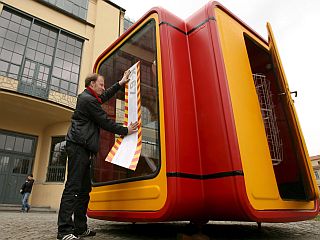
For years, it was a common sight throughout the former Yugoslavia – and as far away as New Zealand. Saša Mächtig’s K-67 kiosk could be seen on street corners of almost every town. The design was not just supremely practical, it also impressed international magazines, and was even exhibited at the Museum of Modern Art in New York.
The story began in 1966 when Mächtig, then still in his mid-twenties, came up with a strikingly modern design for a kiosk. Its fiberglass body made it inexpensive to manufacture, while its modular design made it highly versatile: It could function just as effectively as a newspaper stand, a market stall, or a fast food joint – all the customer had to do was connect the pieces as needed.
The K-67 kiosk became a rare example of an avant-garde design that came to be produced in mass quantities. From its Slovenian factory - Imgrad in the town of Ljutomer -, the kiosk took Yugoslavia by storm and quickly became an unmistakable part of cityscapes from Slovenia all the way to Macedonia. In a real-life example of imitation being the sincerest form of flattery, the K-67 was so popular that it inspired several unauthorized clones. Eventually, Imgrad’s originals spread to other communist countries, New Zealand, and even Japan - one of the world’s most design-conscious countries.
After a long and successful run, the production of the K-67 kiosk came to an end in the 1990s, but Mächtig’s creation lived on. When MoMA in New York organized a retrospective of the best 20th century design, the K-67 was among the iconic objects chosen for the exhibition. And hundreds of the kiosks remain in service throughout post-communist Europe, testifying to both the quality of the build and the longevity of Mächtig’s idea.
In the years after devising the K-67 kiosk, Mächtig became leading Slovenian design theorist, and in 1984, he helped to found the Department for Design at Ljubljana’s Academy of Fine Arts – Slovenia’s first such institution. He has spent decades passing on his extensive knowledge of the field to new generations of designers eager to leave as big of a mark on the world of design as he has.

































































